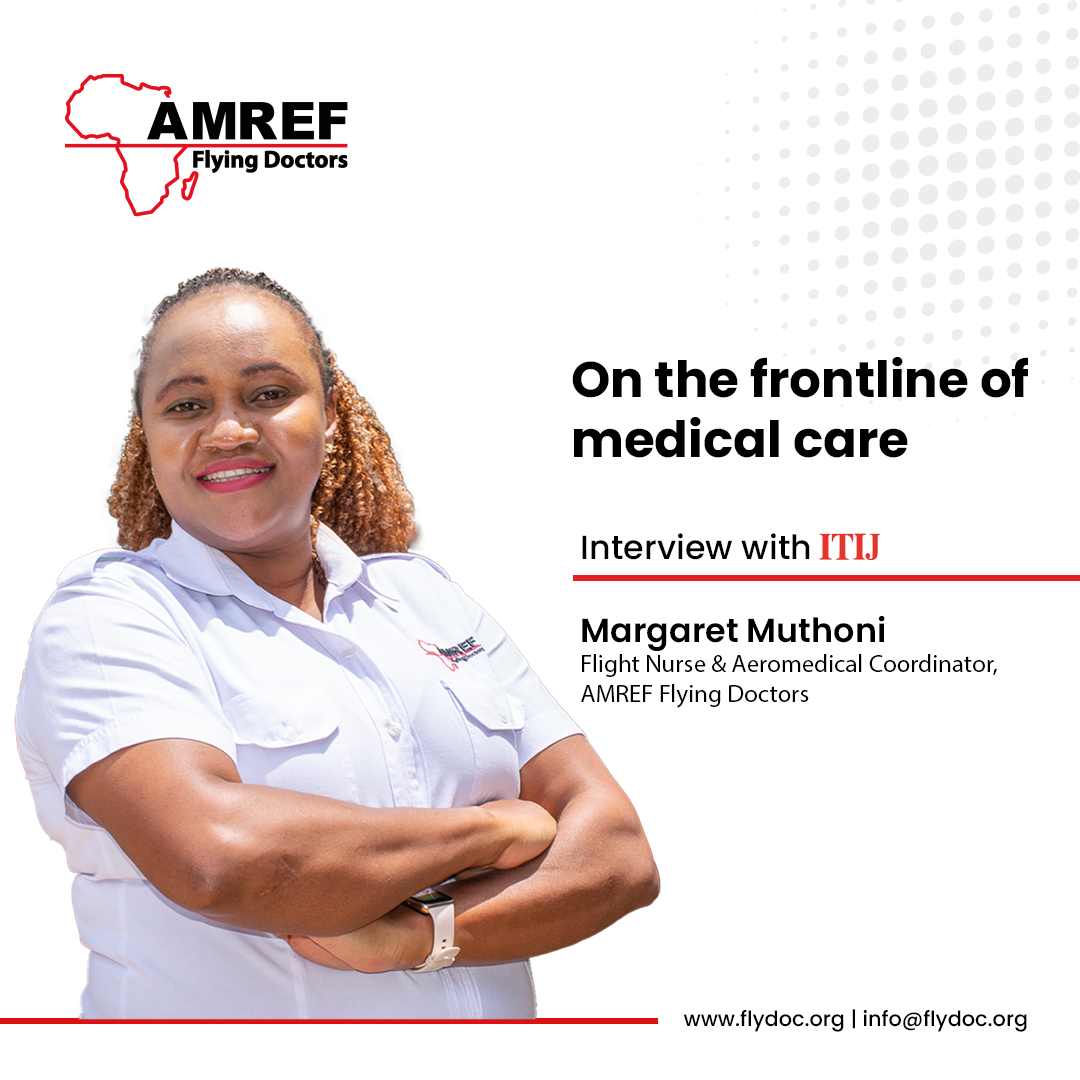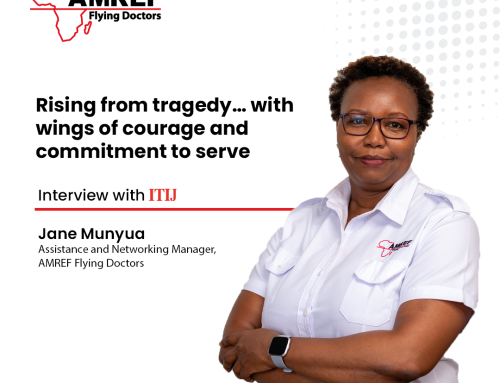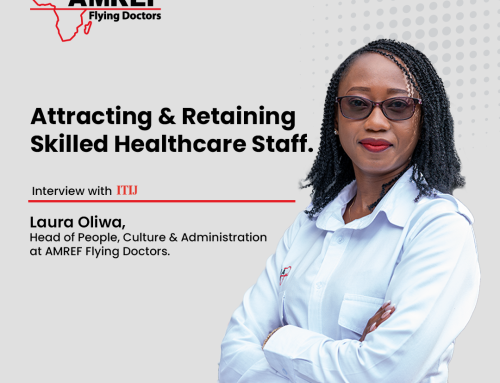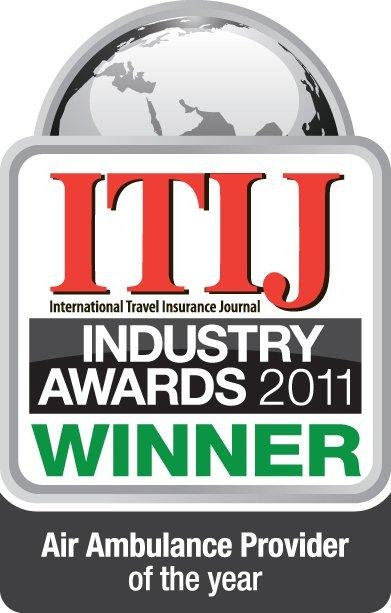A conversation with Margaret Muthoni, Flight Nurse and Aeromedical Coordinator at AMREF Flying Doctors
In this exclusive interview, ITIJ speaks with Margaret Muthoni, Flight Nurse and Aeromedical Coordinator at AMREF Flying Doctors. From hospital halls to the skies, Margaret reflects on what drew her into aeromedical care, the teamwork that makes every mission possible, and the unforgettable cases that remind her why she does what she does. Among them is the evacuation of a two-year-old child who required peritoneal dialysis mid-flight – a mission that tested every skill and reminded her of the profound impact of this work.
It wasn’t about adrenaline, it was about making a difference where seconds truly matter
What drew you to become an emergency flight nurse, and how does your role differ from working in a hospital setting?
My nursing journey has been fascinating. I started in a military hospital, where routines were predictable, resources always available, and support never far away. It was an excellent place to learn and grow, but I soon felt the urge to step outside those walls. I wanted to meet patients at the raw, unpredictable point where their stories begin. Becoming a flight nurse wasn’t about adrenaline or adventure, it was about being there in the moment when seconds truly matter, when your actions can change the outcome of someone’s life.
From your perspective, what makes AMREF Flying Doctors different from other air ambulance providers?
AMREF Flying Doctors is unique in both our geographic location and our operations. From Nairobi, we can reach some of the most remote parts of Africa quickly. But it’s more than geography, it’s our principle of the ‘Golden Hour’. When a call comes in, we move with urgency, compassion, and precision. What also sets us apart is that every mission supports the wider work of Amref Health Africa, ensuring that even as we save lives in the air, we contribute to lasting health change in Africa.
A well-planned mission reduces stress, while post-flight debriefs allow us to reflect and improve
Q1. How does the multidisciplinary teamwork between medical and aviation crews contribute to the success of a mission?
Every evacuation is a coordinated effort. Our medical teams, flight operations staff, and pilots work hand in hand from the moment a call is received. Pre-flight briefings bring everyone together to discuss the patient’s condition, flight plan, and possible complications. The medical team prepares the equipment and care strategy, flight operations team secure clearances and logistics, and the pilots ensure a safe and timely flight. We all rely on each other, and that mutual trust makes missions smooth, safe, and successful.
Q2. Could you walk us through the importance of equipment checks and preparation between missions?
Equipment checks are at the heart of every safe evacuation. Before each flight, we go through every monitor, oxygen cylinder, and piece of kit, following detailed checklists. Everything must be fully charged, functional, and ready to use. In the air, there’s no room for trial and error, so this preparation becomes second nature. It not only ensures patient safety but also gives the crew confidence, knowing the tools we depend on will perform when needed most.
The child needed peritoneal dialysis during the flight something rarely performed in an air ambulance
Q3. How do short regional flights differ from long-haul intercontinental transfers in terms of patient care and the challenges you face?
Regional flights are fast-paced. Within Kenya and across East and Central Africa, we use the Pilatus PC-12 – a pressurised, single-engined, turboprop aircraft when speed is critical. These missions usually involve patients coming straight from accident scenes or smaller facilities, needing urgent stabilisation and transfer to higher-level hospitals. Time is everything, and quick intervention is vital.
Long-haul flights are far more complex and demand exceptional coordination. These intercontinental missions are typically operated using our jet aircraft, purpose equipped for extended-range medical evacuations. Each flight requires detailed planning, from oxygen supply calculations and additional medical equipment, immigration clearances, and, in some cases, crew changes. These missions are a true test of endurance and precision, ensuring the patient remains stable and well cared for throughout the many hours in the air.
Q4. Apart from air ambulance flights, you are also involved in ground ambulance transfers and medical escort services on commercial flights. How do these compare in complexity and patient needs?
Each service comes with its own unique requirements based on the medical condition, urgency, distance, and logistical needs. Ground ambulance transfers range from simple referrals to critical ICU cases. Our ambulances are equipped with Advanced Life Support and staffed by skilled medical crews; critical care nurse and a doctor available for urgent situations. We also respond to road accidents where speed and preparation are crucial.
Commercial escorts are more complex. The patient must be stable enough to fly, and approval is required from the airline. Equipment is limited, so arrangements like oxygen or stretchers need careful coordination. A bedside assessment is essential to confirm fitness to fly and to align with both treating doctors and airline medical teams.
Each service comes with its own unique requirements based on the medical condition, urgency, distance, and logistical needs
Q5. Can you share any cases where AFD handled extraordinary missions?
We often encounter extraordinary cases, but one that stands out was the evacuation of a two-year-old from Iringa, Tanzania, to Mumbai. The child needed peritoneal dialysis during the flight – something rarely performed in an air ambulance. The mission required meticulous planning, specialised equipment, and seamless teamwork. Safely handing the child over to the hospital in Mumbai was one of those unforgettable moments that reminds us why we do this work.
Q6. Air ambulance nursing can be demanding, both physically and emotionally. How do you personally manage the stresses of long flights and high-pressure situations?
Preparation makes all the difference. A well planned mission reduces stress, while post-flight debriefs allow us to reflect and improve. Personally, I make time to reset through exercise, reading, or simply taking a quiet moment. Maintaining balance between work and well-being is essential. It keeps me resilient, ready for the next call, and able to give my best to every patient.
First Published: The International Travel & Health Insurance Journal (ITIJ) _ Nov | ITIC Global Edition
Author: Margaret Muthoni – Flight Nurse and Aeromedical Coordinator, AMREF Flying Doctors
Editor: Jane W. Muthoni













